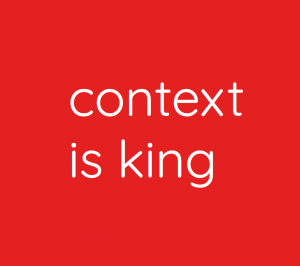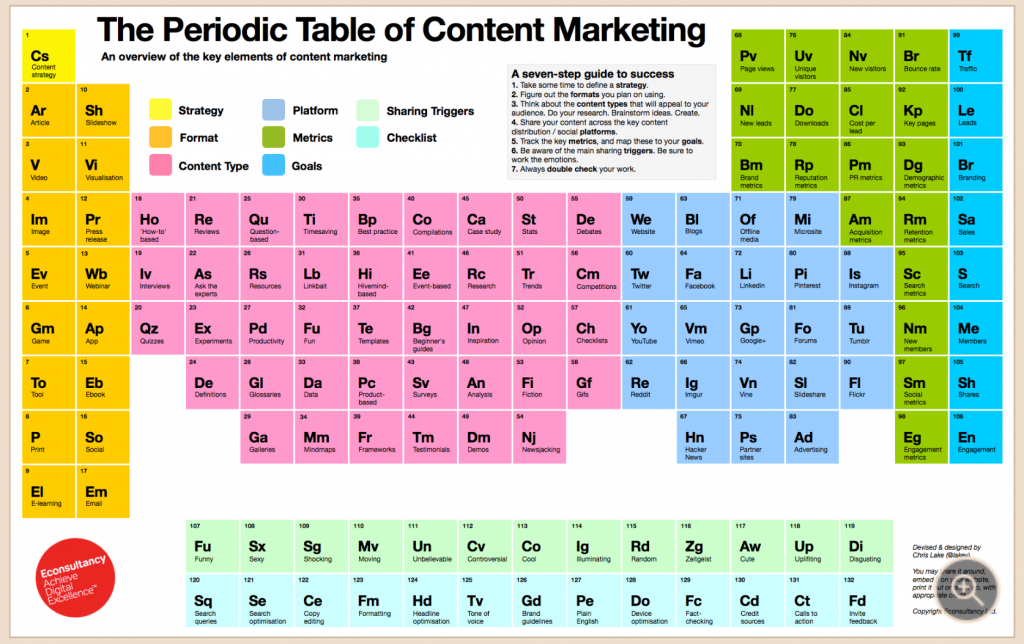What content marketers can learn from the history of journalism

Original post, May 2014 at lærkespenner.dk
Since the beginning of the “content is king” wave, there has been a lot of irrelevant and pushy content clotting my social media feed. This, I guess, is caused by some content marketers considering content as ads and trying to push a sale on the very first encounter with me, their looming customer.
When creating your content there’s a lot of different aspects you have to consider. Chris Lake demonstrates this beautifully in his Periodic Table of Content Marketing although I do feel that the strategy or the why doesn’t take up enough space in the table
In my opinion great content is the cement that makes a long term relationships between you and your customer possible. Whether your prime goal is to sell, change somebody’s attitude, get somebody to recommend you or create brand awareness, great content doesn’t come from thinking strictly in sales, it comes from acknowledging the relevance as well as the important values of the people that come across your content.
When creating content my focus is always on the WHY, but that doesn’t make the HOW less important! So here comes the tricky part! How do you do that? How can you possibly create content that is relevant and engaging for a diverse group of people and still maintain the unique voice of your brand?
Why not learn from the people that have been doing this for many years? Journalists have been working with relevance for many decades. Their goal is not just to get people to read their article, but also to get them to want more, to pay attention to a certain topic, to start a buzz regarding a certain topic and to become loyal customers of their news platform. And make no mistake… journalists are also working under the restrictions of tone of voice, unique selling points and brand equity.
Dealing with news is dealing with relevance, which is why content marketers can learn a lot from journalism. Journalists (at least in Denmark) have certain criteria as to what qualifies as news. These criteria can also help you determine whether or not your target group will regard your content as relevant, engaging and shareable.
The news criteria
The news criteria can differ from place to place but some of the central criteria are: Impact, timeliness, human interest, sensation, identification, proximity, conflict and prominence.
Content created from the assessment of impact, human interest, conflict and sensation focuses on trends, entertainment value and spectacular, upsetting or surprising news. These are good for gathering quick attention, but they won’t do your brand any good unless they are also consistent with one or more of the three criteria that are most valuable when creating content meant for long term engagement:.
Identification
Proximity
Prominence
Identification: This criterion points out that you have to have the culture, interest and relevance of your prospects or customers in mind when assessing your content. Identification is all about emotions so make it personal and take advantage of the emotional framing effect:
Put yourself in the customers place and consider this: Does this have anything to do with people, places or subjects in my near environment? How can I relate to this? What’s in it for me? How will this affect people I know? How will it affect the aspects of my near environment? And what are the consequences for me personally?
Keep in mind that there is no such thing as objective relevance; it all comes down to individual assessments and social context! So if you are going to create content that people can identify with, you have to know your target group. You probably know a lot from your collected data already, but don’t forget to listen.
Proximity: Topics and events that we feel close to are regarded as more important than distant ones. This criterion points out that building your content on shared culture, values and interests will help eliminate the gap between you and your customer. But keep it real. Your company’s culture and values can be the perfect building blocks for a long term and personal relationship with your prospect or customer. Content that is meant to show off culture and values is easiest to relate to if it comes as personal examples or stories. So don’t be afraid to show off your company’s personality. People will judge you and your company from a set of human attributes anyway.
Prominence: Content featuring well-known personalities, categories, debates, conflicts and so on are easier to relate to and can drive more engagement. Therefore, it is a good idea to place your content within a contextual frame that your customers know and feel passionate about. After all it is a lot easier to engage with others over a topic you know and have an opinion about. This, of course, is more straightforward for companies dealing with culture, politics or shared hobbies. But think about it, every company has a special place within our society, and that place will relate to debates on a larger scale, even if you choose to ignore it. For instance we all have opinions about good vs. bad customer service, quality vs. quantity, gender politics and so on.
Working systematically with this perspective
Do to the large amount of elements it is difficult to draw up a content marketing model based on the news criteria. Content marketing from this perspective should be a circular motion. Content assessment should happen consistently with changes in society, new target groups and development within the company.
So what kind of well-known categories or debates can you relate your content to and what is your special and unique take on them? How can you show off your shared values and interests and what kind of personal identification points do your content hold?
If content marketing is done right, people will feel the need to share because they can identify with it. So no more pushing bad or irrelevant content, instead get to know your customers and prospects, give them the part of you that they want and need, and they will do the selling for you.